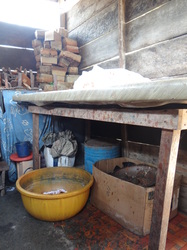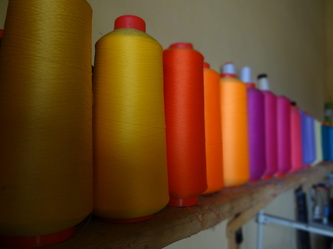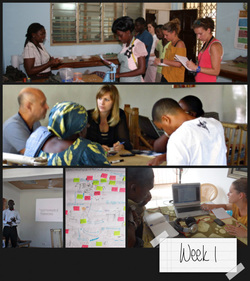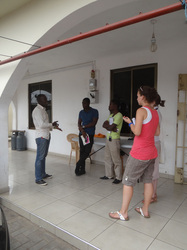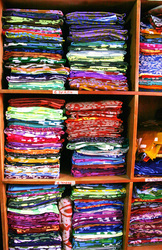
Monday we started off doing a batiking workshop at the workplace of mama Martha. She talked us through the batiking process and helped us understand it more. We started off choosing the stamps we wanted to use for our patterns, while the wax was being heated. The mamas showed us how to dip the stamps in the wax and shake it off without getting the hot wax on yourself or somebody else. This was more difficult than it looks! When the patterns were finished it was time to choose a colour to dye the fabric with. After dyeing the fabric is hung outside to dry and we could see the colour changing from dark brown in the wet situation to orange in the dried situation. It looked amazing!
After the workshop Anna Rose and Patience, from Global Mamas, met us and took us to Cape Coast. Here we visited several other mamas at their businesses. In total we visited 3 seemstresses and 3 batiking workplaces. This gave us a good impression of how the mamas worked and what kind of space they need. We asked them questions on what they would like to change about their workplace, what they would like to improve or what could make their workplace a more comfortable place to work in. Most of the women had never really thought about it before. They are used to their place as it is and they like it.
After meeting the mamas we went to the Global Mamas office in Cape Coast. The office in Cape Coast is different from the one in Ashaiman. In Cape Coast the mamas have their own businesses and consider Global Mamas as one of their customers, whereas in Ashaiman there is one main building, which employs 24 people, where the whole process takes place under one roof. Patience showed us around at the office and walked us through the process. To make it more visual they picked a finished product from the shelf and moved it through the different stages of the quality control. This way it became clear how much is happening in such a small room.
Lisanne
After the workshop Anna Rose and Patience, from Global Mamas, met us and took us to Cape Coast. Here we visited several other mamas at their businesses. In total we visited 3 seemstresses and 3 batiking workplaces. This gave us a good impression of how the mamas worked and what kind of space they need. We asked them questions on what they would like to change about their workplace, what they would like to improve or what could make their workplace a more comfortable place to work in. Most of the women had never really thought about it before. They are used to their place as it is and they like it.
After meeting the mamas we went to the Global Mamas office in Cape Coast. The office in Cape Coast is different from the one in Ashaiman. In Cape Coast the mamas have their own businesses and consider Global Mamas as one of their customers, whereas in Ashaiman there is one main building, which employs 24 people, where the whole process takes place under one roof. Patience showed us around at the office and walked us through the process. To make it more visual they picked a finished product from the shelf and moved it through the different stages of the quality control. This way it became clear how much is happening in such a small room.
Lisanne
